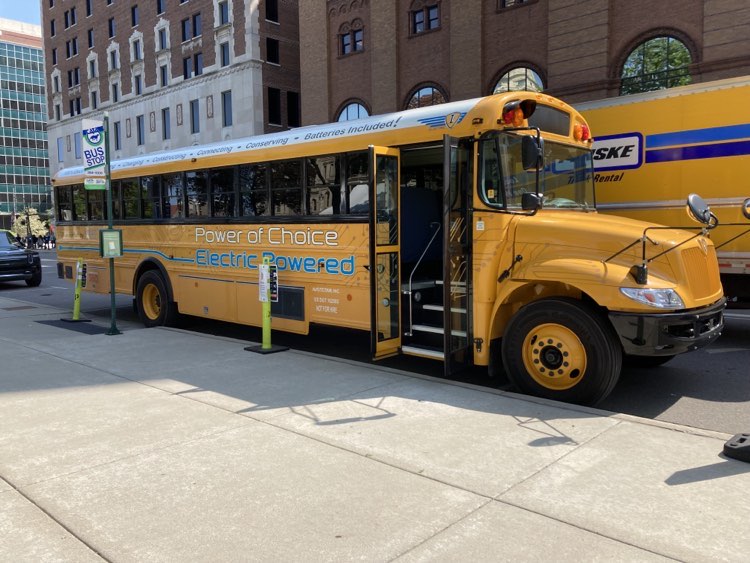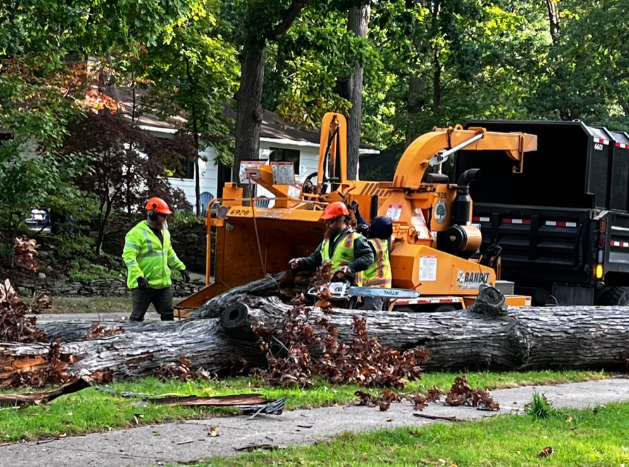A Look at EGLE’s Materials Waste Management Division

The Materials Management Division (MMD) of the Michigan Department of Environment, Great Lakes, and Energy (EGLE) oversees solid and hazardous waste programs, radioactive materials activities, a radon awareness program, recycling, and energy programs. We interviewed the director of the division, Elizabeth Browne, to get some insights. Q: How do you think energy efficiency, recycling, and pollution prevention are interconnected when it comes to fostering sustainability in Southeast Michigan? A: I have always felt you can’t have any without the others, and they are all key to having a sustainable system. Maybe it’s my biologist background. Recycling facilitates energy efficiency since it translates to diverting items from landfills. If you have a good system, you are reusing and recycling materials nearby, you save energy by not transporting material across state lines. When we look at energy efficiency, it works the same way. If we decrease the effort and resources put into heating, cooling, water usage, and transportation systems by becoming more efficient, we have more resources to allocate elsewhere. And isn’t that the very heart and definition of sustainability? Q: How do environmental justice and underrepresented communities factor into these efforts in Southeast Michigan? A: They factor in highly. There are federal funding requirements to help regulate this. The federal Justice 40 program deems that 40% of grant funds be used in underrepresented communities. Even before that, this was a focus for us. If you look at any of our requests for proposals, we pay special attention to projects coming from underrepresented communities – places where the community’s ability to be more sustainable has been stressed. We are always trying to level the playing field. Q: You work with state and federal partners, entrepreneurs, companies, organizations, and communities to reduce Michigan’s reliance on nonrenewable energy. Can you tell us more about this work? A: We work with federal partners in seeking every grant opportunity that we feel we have a nexus with. We work with companies and organizations through the Retired Engineers, Scientists, Technicians, Administrators, Researchers, and Teachers (RESTART) program. This is a group of retired professionals who work with entities to identify where they have energy issues or where renewable energy options may be a benefit. We do energy audits for houses of worship, schools, and municipal buildings. In many cases, these buildings are older and not efficient, so we offer ideas on how to improve efficiency and look at renewable options. This helps them save financial resources that they can then allocate elsewhere. We have received grant money through the Charge Up Michigan Program to install fast chargers in communities. Within this program, the cost of charger installation is divided amongst the location owner, the utility provider, and EGLE. This allows us to install more chargers, and it helps the utilities get closer to their energy efficiency goals and benefits the property owner or business. We have worked with communities to replace diesel- and gas-powered vehicles with electric ones, including Willow Run Airport and the City of Detroit. In Detroit, we replaced diesel-powered garbage trucks with EVs. We work heavily with NextCycle and the Centropolis Accelerator program at Lawrence Technological University. These are both programs to support businesses in their early stages. NextCycle is geared toward recycling activities, and the Centropolis Accelerator focuses on clean technology and the circular economy. Q: What are your biggest challenges in materials management? A: The thing that keeps me up at night is navigating grant programs. There is this huge influx of federal money, but there are a lot of checks and balances, and trying to manage the funding appropriately is a challenge. There is a lot of hurry-up-and-wait involved. We have a phenomenal team, and I don’t want to break their backs as they work to move the money out to recipients. Q: What are your highest priorities? A: Moving as much of the funding to those who need it and doing it in a way that is equitable and fair and hits the highest needs. Sometimes we make decisions that aren’t flashy, but the impact they have on that community is significant. A small community getting a few solar panels to help power their community building so the kids have someplace to go after school is a good example. We try to disburse the money in a way that supports as many communities and people as possible. Q: What does the future look like? A: I think it keeps getting brighter. The Michigan Legislature recently passed an eight-bill package that updates solid waste laws and will ensure we have sufficient landfill capacity. We just held our Virtual Michigan Materials Management Conference and had almost 600 people from 11 states represented. Getting EV chargers out across the state and seeing more and more interest in communities in terms of electrification is good progress. There is so much potential for economic growth in the energy and recycling fields. It’s astronomical. This excites me. Every day, I see people and companies that are looking for support and direction on becoming more sustainable. More and more companies understand the need to be sustainable because the public is demanding it, and it’s also for their own good. I encourage everyone to reach out to us. People interested in any EGLE grant programs can go to Michigan.gov\EGLE and search for “grants and financing.” For more information about all things Materials Management Division, our web pages can be found at Michigan.gov/EGLE/about/organization/materials-management. Be sure to subscribe to our newsletter for regular updates on sustainable business practices in and around Detroit.
Working to Sequester Carbon Within Urban Wood

According to Tiffany Giacobazzi, Ann Arbor urban forestry & natural resources planning coordinator the Ann Arbor Forestry Department, the city of Ann Arbor loses about 600 trees per year. This reduces its carbon storage capacity dramatically. Much of the loss sits within furniture-grade urban lumber, meaning the trees can be repurposed for furniture or other long-lived urban wood goods that aid in sequestering carbon, versus being used for mulch or firewood or being diverted to landfills. Ann Arbor has partnered with Urban Ashes to implement its Circular UrbanWood Triconomy™ (CUT Model™). This model is meant to ensure that logs are put to their highest and best use to sequester as much carbon as possible. SBN Detroit spoke with Paul Hickman, Urban Ashes founder, CEO, and principal designer, and Tiffany Giacobazzi, Ann Arbor urban forestry & natural resources planning coordinator, to find out more. Q: What is Urban Ashes, and how did this program with Ann Arbor come to be? Hickman: I will provide a little background here for context because Urban Ashes has gone through a bit of an evolution. Initially, it started with a major career change for me by taking a job in California with one of the first sustainable lumber companies in the world. I eventually moved back to Michigan and started the original Urban Wood Project with three others in the early 2000s in response to the infestation of the emerald ash borer to help utilize trees beyond mulch, which was the most common response for the disposal of ash trees then and now. That was the impetus, but it immediately expanded to include all fallen urban trees and into Urban Ashes. Urban Ashes grew to sell to over 250 retail partners across 43 states over ten years, repurposing hundreds of tons of lumber into picture frames, furniture, and other items. From the beginning, our focus was also to work with formerly incarcerated individuals as a labor force, and that remains a strong component of the Urban Ashes business model today. Over time, the lack of wraparound (support) services (for workers) took a heavy toll, and eventually, we shifted entirely, shut down our manufacturing, and decided we needed to focus on building the infrastructure to develop the supply chain more thoroughly and consistently and grow the markets for utilization as well as develop the critically needed wraparound services needed for our target labor pool. So, we partnered with NextCycle Michigan and went through their FLOWS track which led to an EGLE grant. Then came the vision for the Circular UrbanWood Triconomy™. We were fortunate enough to work with the University of Michigan graduate students for 18 months to validate the viability of the model, and beginning in 2021, we have piloted it with the city of Ann Arbor. Q: How and why did the city of Ann Arbor come to change the way it processes trees and work with Urban Ashes? Giacobazzi: As the city has shifted with its sustainability goals and A2Zero plan, we started to look at how we could divert more out of the waste stream. We wanted to achieve the highest best use for materials that come out of the urban forest. So, we connected with Urban Ashes and partnered on this project. I have support all up and down the line from city administration which is really important. We are fundamentally changing the way we are dealing with urban wood and our urban forest so we must all be in support of this new process. Q: What does this program involve? Hickman: For years, all fallen urban trees in Ann Arbor (as is the case with most cities) were used for mulch or firewood. Accordingly, Ann Arbor loses approximately 1,111 metric tons of carbon every year and we were able to show them that by implementing the CUT Model™, we can capture upwards of 700 metric tons of that 1,111 and keep it in use and sequestered. The process involves cutting the trees down in a way that holds the most carbon and is best suited for the mills. The process also involves setting up the mills, facilities, contracts, and tracking methods, and then implementing everything. So, that is the work that Urban Ashes has been doing. Q: What do you, as the Urban Forestry and Natural Resources Planner, hope to achieve through Circular UrbanWood Triconomy™? Giacobazzi: I want to make sure the trees and lumber that have to come out in Ann Arbor go to the best use possible. I want it diverted from the waste stream and we are looking to lock up the carbon for as long as possible. We put such time and effort and thought into the development, care, and maintenance of our urban forest, it seems that the next natural best step is to complete the lifecycle of these trees and extend the usefulness of the trees once they die or have to come out. Q: In what ways has the lumber from Ann Arbor been repurposed? Hickman: Typically, the lumber goes to mills to be cut into slabs or dimensional lumber, kiln-dried, and processed, and then is sold as raw lumber to manufacturing or local woodworkers. The wood is then used for items such as furniture, frames, ceiling/wall cladding, flooring, household trim packages, decorative pieces, and more. Q: What other cities are you working with? Hickman: We are farthest along with Ann Arbor. But we are also working with Grand Rapids and are in talks with Detroit, Lansing, Traverse City, and several others outside of Michigan. In terms of businesses, we are working with a startup through Centrepolis called Lily Pad Labs out of Holland, Mich., to provide urban black locust for decking and tables for their autonomous electric boats. We are also working in conjunction with Centrepolis to help bring Daika Wood’s game-changing urban wood waste processes and products to Michigan. These are a few of the things we have happening at the moment. Q; In what ways do you think Urban


